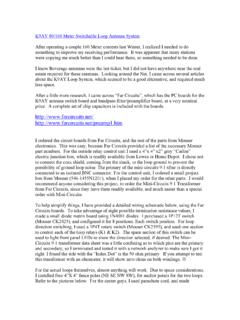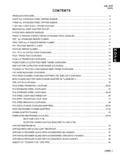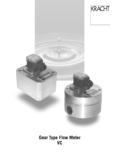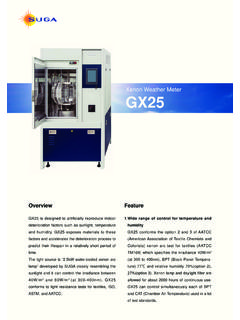Transcription of Ultrameter Operation Manual Model 4P - [Official] …
1 Ultrameter Operation ManualModel 4P10 - 02 (WEB) EGMYRON LCOMPANY7-11-00 Instrument IllustrationMSMRMMYYRROONN LL CCOOMMPPAANNYY4 PCONDRESTDS These 3 Measurement keys will: Turn instrument on Measure parameter Exit any function(Built-inElectrodes)Preprogramme d variable conductivity/TDS ratiosParameters (3)Wrist/neck strap slot (user supplied)This key for: Calibration Memory Clear Solution selection ConfirmationUp key/Memory StoreDown key/Memory RecallConductivity CellUSER mode for programming special temperature compensationfactor and conductivity/TDS ratioDisplayed here: Temperature readout USER temperature compensation or conductivity/TDS ratio Memory Storage/ RecallBUFFERPPMPPT SmSKM CRATIO% /KCl442 NaClUserLOBATT CAL MEMORYRESTDSCONDFor detailed explanations see Table of ContentsUnits of Measurement Megohms - cm Kilohms - cmmS - millisiemens/cm (millimhos/cm) S - microsiemens/cm (micromhos/cm)PPM - parts per millionPPT - parts per thousandParameterResistivityResistivityC onductivityConductivityTDSTDST emperature SensorMCLRCAL1 ULTRAMETERTMFEATURES and SPECIFICATIONSA.
2 Features Superior resolution 4 digit LCD displays full 9999 S/ppm. Accuracy of 1% of reading (not merely full scale). All electrodes are internal for maximum protection. Latest 4 electrode cell technology. Waterproof to 3 feet/1 meter. Autoranging conductivity/TDS/resistivity. Memory saves 20 readings. Factory calibrations stored in microprocessor. 3 conductivity/TDS solution conversions preprogrammed into microprocessor. USER feature allows:Programming your own cond/TDS conversion your own temperature compensation temperature General SpecificationsDisplay 4 Digit LCDD imensions (LxWxH) mmWeight Material VALOX*Cond/Res/TDS Cell Material VALOX* Cond/Res/TDS Cell Capacity mlPower 9V Alkaline BatteryBattery Life >100 Hours/5000 ReadingsOperating/Storage Temperature 32-132 F/0-55 CProtection Ratings IP67/NEMA 6 (waterproof to 3 feet/1 meter)* GE information available on our web site Specification Chart D.
3 Warranty/Service If, in the opinion of the factory, failure was due to materials orworkmanship, repair or replacement will be made without charge. Areasonable service charge will be made for diagnosis or repairs due tonormal wear, abuse or tampering. This warranty is limited to the repair orreplacement of the Ultrameter only. The Myron L Company assumes other responsibility or ModelsULTRAMETER MODELS3P4P 6 PPARAMETERS pH/ORP/Temp. Conductivity/TDS Conductivity/TDS/pH Resistivity/Temp. Resistivity/ C32 - 160 F0-71 C32 - 160 F0-71 C32 - 160 FMYRON L COMPANY 2450 Impala DriveCarlsbad, CA 92010 USA760-438-2021 1 % of reading**0-71 C32 - 160 F 0-9999 S10-200 mSin 5 autoranges 1 % of reading* 1 % of reading*0-9999 ppm10-200 pptin 5 (<100 ppm) (<1000 ppm) (>1000 ppm)Auto Temperature CompensationAdjustable Cond/TDS Ratio - Ratios PreprogrammedKCl, NaCl, 442 0 - CAdjustable Temperature Compensation0 - C 0 - (<100 S) (<1000 S) (>1000 S) (<100K ohms ) (<1000K ohms ) (>1 M ) C/FResolutionRanges CAccuracyConductivity TDS Resistivity10K - 30M ohmsTemperature4P* up to 100mS/ppt; 100 - 200mS/ppt: 1 - 2% typ.
4 **10K ohms - 10M ohms All Myron L Ultrameters have a 2 year warranty except for pH sensorswhich have a 6-month limited warranty. If an instrument fails to operate properly, see the Troublshooting Chart, pg. 21. The battery and pH/ORPsensor are user replaceable. For other service, return the instrument prepaid to the Myron L OF CONTENTSI nstrument Illustration ..1 FEATURES and SPECIFICATIONS .. 2A. Features .. 2B. General Specifications .. 2C. Specification Chart .. 3D. Warranty/Service ..3E. Ultrameter Models ..3I. INTRODUCTION ..7II. RULES of Operation .. 7A. Operation ..7B. Characteristics of the Keys .. 7C. Operation of the Keys .. 81. Measurement Keys in General .. 82. COND, RES and TDS keys ..83. CAL/MCLR key .. 84. UP or DOWN keys ..9 III. AFTER USING the Ultrameter Maintenance of the Conductivity Cell.
5 9IV. SPECIFIC RECOMMENDED MEASURING PROCEDURES ..9A. Measuring Conductivity/Total Dissolved Solids ..9B. Measuring Resistivity .. 10V. SOLUTION SELECTION ..10A. Why Solution Selection is Available.. 10B. The 4 Solution Types.. 10C. Calibration of Each Solution Type ..10D. Procedure to Select a Solution .. 10E. Application of USER Solution Type ..111. User Programmable Tempco .. 112. Disabling Temperature Compensation .. 123. User Programmable Conductivity to TDS Ratio .. 12VI. CALIBRATION ..13A. Calibration Intervals ..134B. Rules for Calibration in the Ultrameter .. 131. Calibration Steps ..132. Calibration Limits ..14C. Calibration Procedures .. 141. Conductivity or TDS Calibration ..142. User Calibration Conductivity/TDS ..153. Resistivity Calibration .. 154. Reloading Factory Calibration ..155. Temperature Calibration.
6 16 VII. MEMORY ..16A. Memory Storage .. 16B. Memory Recall ..16C. Clearing a Record/Memory Clear .. 16 VIII. CHANGING from CENTIGRADE to FAHRENHEIT ..17IX. TOTAL RETURN to FACTORY SETTINGS .. INTERVALS ..19A. Suggested Intervals ..19B. Calibration Tracking Records .. 19C. Conductivity, RES, TDS Practices .. and MAINTENANCE ..20A. Temperature Extremes .. 20B. Battery Replacement .. 20C. Cleaning Cell Cup ..22A. Conductivity/TDS Standard Solutions .. 22B. Soft Protective Case .. 22C. Data Port ..22D. pH Buffer Solutions .. 23E. pH Sensor Storage Solution .. COMPENSATION (Tempco) of Aqueous Solutions .. 23A. Standardized to 25 C ..23B. Tempco Variation .. 23C. An Example .. 24D. A Chart of Comparative Error ..25E. Other Solutions .. CONVERSION to TOTAL DISSOLVED SOLIDS (TDS) ..26A. How it s Done ..26B.
7 Solution Characteristics ..26C. When does it make a lot of difference? .. COMPENSATION (Tempco) and TDS DERIVATION ..27A. Conductivity Characteristics .. 27B. Finding the Tempco of an Unknown .. 28C. Finding the TDS Ratio of an Unknown ..29 NOTES .. 30 Addendum RESISTIVITY MEASUREMENTS ..1 Offset Zero Calibration ..1 Cell Check.. MODE GAIN CALIBRATION .. 3A. Calibration of Ultrameter for Use in User Mode .. 3B. Setting User mode Calibration Link .. 3C. Canceling User Mode Calibration Link .. 4* CHECKING YOUR INSTRUMENTS SOFTWARE VERSION .. 56I. INTRODUCTIONT hank you for selecting the Ultrameter Model 4P, one of the Myron LCompany s latest in a new line of instruments utilizing advancedmicroprocessor-based circuitry. This circuitry makes it extremely accurateand very easy to use (see pages 2 & 3 for Features and Specifications onthis and other models).
8 For your convenience, your Ultrameter has a briefset of instructions on its bottom, and a pocket sized card with abbreviatedinstructions is included with the note .. Conductivity, Resistivity, and TDS require mathematicalcorrection to 25 C values (ref. Temperature Compensation, pg. 23). Onthe left of the Ultrameter s liquid crystal display is shown an indicator ofthe salt solution characteristic used to Model temperature compensationof conductivity and its TDS conversion. The indicator can be KCl, NaCl,442 or USER. Selection affects the temperature correction ofconductivity, and the calculation of TDS from compensated conductivity(ref. Conductivity Conversion to Total Dissolved Solids (TDS), pg. 26).The selection can affect the reported conductivity of hot or coldsolutions, and will change the reported TDS of a solution. Generally,using KCl for conductivity, NaCl for resistivity, and 442 (Natural Watercharacteristic) for TDS will reflect present industry practice forstandardization.
9 This is how your instrument, as shipped from the factory,is set to operate. II. RULES of OPERATIONA. OperationUsing the instrument is simple: Rinse the conductivity cell with test solution 3 times and refill. Press the desired measurement key to start measurement. Pressing the key again does no harm and restarts the 15 second off timer. Note the value displayed or press the MS key to store (ref. Memory Storage, pg. 16). It s that simple! B. Characteristics of the Keys Though your Ultrameter has a variety of sophisticated options, it is designed to provide quick, easy, accurate measurements by simply pressing one key. All functions are performed one key at a time. There is no off key. After 15 seconds of inactivity the instrument turns itself off (60 seconds in CAL mode). Rarely will a key be required to be held down (as in Procedure to Select a Solution, pg.)
10 10 or Conductivity or TDS Calibration, pg. 14).7C. Operation of the Keys (See Instrument Illustration on page 1)1. Measurement Keys in GeneralAny of the 3 measurement keys in the upper part of the keypad turns onthe instrument in the mode selected. The mode is shown at the bottomof the display, and the measurement units appear at the right. Pressing ameasurement key does this even if you are in a calibration sequence andalso serves to abandon a change (ref. Leaving Calibration, pg. 14).2. COND, RES and TDS keysThese 3 keys are used with solution in the Conductivity Cell. Precautions: While filling cell cup, ensure no air bubbles cling on the cell wall. If the proper solution is not selected (KCl, NaCl, 442 or USER) refer to Why Solution Selection is Available, pg. 10 and Procedure to Select a Solution, pg. COND KeySolution to be tested is introduced into the conductivity cell and a press of displays conductivity with units on the right.








